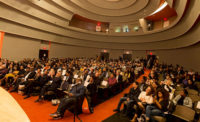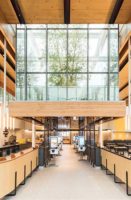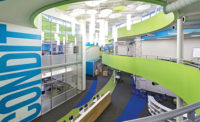The environmental goalpost for buildings has been moved. Clients don’t just want to cut VOCs and energy use, they want architects to help them significantly reduce a project’s carbon footprint—including the impact of individual components before they’re installed. Amid the pressure to surpass even LEED standards, two architects from RECORD’s latest and past Products of the Year contest juries shared their view of next steps.
With increasingly stringent certifications cropping up, which ones truly measure sustainability?
Arno Adkins: LEED remains the widely accepted standard for measuring building performance. It is, however, only one standard of measuring building performance. We’ve become increasingly focused on using others, such as Living Building and WELL, as complimentary to LEED. When several are used in concert, a more holistic approach to sustainability, health, and wellness can be achieved.
Jamison Guest: The majority of our consulting projects achieve LEED certification, and some set goals of exceeding the Platinum rating level. But as energy codes continue to evolve and aggressive targets are set to reduce greenhouse gas (GHG) emissions (An example is New York City’s 80x50 plan to reduce GHG 80% by 2050), it will be interesting to see how LEED certification evolves. One promising development would be expansion and greater use of credits using Environmental Product Declarations (EPDs) to quantify energy consumption and GHG emissions associated with a specific building material.
More rigorous standards are better for building occupants. How do they impact your job as architects?
Adkins: Increasingly stringent certifications create the kinds of critical shifts in the marketplace that drive innovation in design, construction, and policy. We’re especially encouraged by the proliferation of standards that create ways of measuring social-equity outcomes. A high-performance building should not only perform well in terms of energy use or its optimized exterior wall, but also allow occupants to perform well and perform well as part of the local ecosystem.
Are you excited about any specific sustainable materials?
Guest: We’re seeing a large number of high profile projects using terra cotta, typically integrated as rain screen cladding onto unitized curtain wall units for high-rise construction. The trend seems obvious at this moment in New York City, but renewed interest in terra cotta has grown steadily over the past 10 to 15 years.
Adkins: Our hope is that building standards and codes begin to further embrace cross-laminated timber (CLT) for a wide variety of typologies. We’re also closely observing some of the advancements occurring in Europe; successful precedents and better understanding of CLT applications go a long way in making the argument for its use.
This story was featured in Material World, Architectural Record’s products-focused newsletter. Subscribe today!









Post a comment to this article
Report Abusive Comment